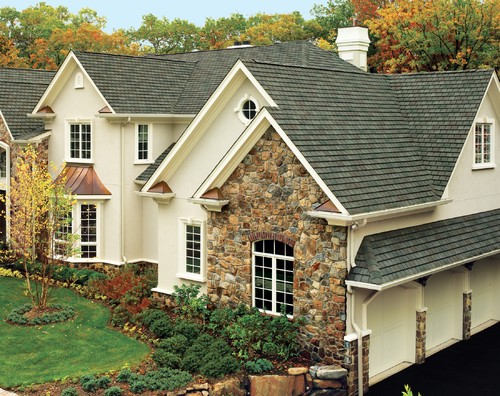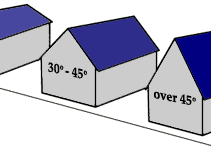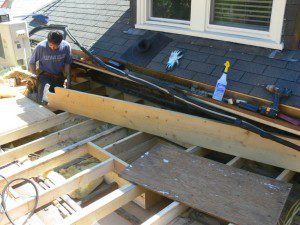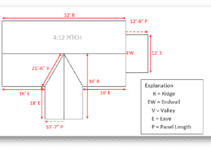It can be difficult to locate the exact spot of a leak because the water spot on the ceiling inside your house may not be in the same location as the actual leak in the roof.
Usually these leaks are caused by localized damage, such as cracked or missing shingles or shakes, or on a flat roof, a blistered or cracked area.

Photo by Dr Roof Atlanta Inc – More exterior home ideas
But once again, the hardest part to repairing this kind of damage is locating it.
The best way to find the true source of the leak is to climb up into the attic on a rainy day. Water will reflect light, so bring a flashlight along. Also, look for water damage on the underside of the roof deck. This should give you the best idea as to the location where repair work will be necessary. Once the leak has been located, the repair process is fairly simple.
Safety Tips:
- Adequate safety measures must be taken for any roof repairs. Always use safety ropes.
- Roof repairs should be done on a sunny day when the roof is completely dry.
- On steep roofs, use a ladder framework to provide secure anchoring.
- The location of power lines should be kept in mind when working on a roof.
- Rubber-soled shoes provide the best traction when working on a roof.
1/ Flat Roofs:
Flat roofs are made up of layers of roofing felt and tar.
You can easy locate the area of damaged roofing felt; this will usually be in the form of a blister.
The solution is to cut the blister center down. Be careful not to damage the intact roofing belt below.
- Squeeze out any water that has collected in the blister.
- Use a propane torch to completely dry the area.
- Coat the bottom of the edges of the blister with roofing cement and press down firmly.
NOTE: If there are large patches of water damage the services of a professional roof repair company are recommended.
2/ Roof Metal Flashing:
Working on a roof metal flashing can be dangerous. Keep these safety precautions in mind before tackling a roof repair:
a) Wear the proper footwear, like rubber-soled shoes, for traction.
b) Secure your ladder on nice, solid ground.
c) Don’t go walking on the roof if it’s still wet and slippery from rain.
d) Use all the time safety ropes.
First of all, you should look where the roofing seal may have been opened and where water may have seeped through.
- Metal flashing is supposed to seal where two surfaces sort of intersect on the roof.
- Seal chimneys and vents, and even skylights.
- If the damage is visible, use a caulking gun to seal the hole back with caulk.
- If you see that the roof cement is cracking or damaged, use a putty knife to apply a generous amount of brand new roof cement. Cover even the roof nails with roof cement.
Advantages and Disadvantages of Slate Roofs (howtobuildahouseblog.com)
3/ Shingle Roofs:
Shingle roofs are usually easy to fix. At the marked leak point, look for damaged, curled, or missing shingles.
Also, at every place where two surfaces meet and around every chimney or vent, look for breaks in the flashing or caulking or for gaps in the lines of roof cement.
Sometimes shingles are also either damaged or even missing. If you find evidence of shingle problems, repairs are fairly simple. Curled-back shingles can be reattached with asphalt roof cement or compound in tubes for use with a caulking gun.
Warning:
a) In warm weather, you can easily straighten out the curled shingle.
b) In cold weather, shingles become very brittle and must be softened before they can be flattened out.
- If a shingle is cracked or damaged beyond roofing repair:
- Lift all the surrounding shingles first and look for any nails that are protruding
- Carefully remove nails with pry bar (also, when shingles are blown off by a storm, remove any protruding nails left in roof)
- Slide the shingle out and scrape out any old roof cement
- Put the new shingle in place and align it with surrounding shingles (to make it easier to slide new shingle into place, slightly round its back corners with sharp utility knife)
- Put the new shingle in place and align it with surrounding shingles
- Use roof cement to cover the heads of the nails to prevent corrosion.
- Inspect the chimney flashing, the flashing around vents or vent pipes, and any line of roof cement where two surfaces meet.
The only way to prevent any more roof leaks are to check your roof shingles and metal flashing at least once a year.
4/ Wooden Shake Roof:
Repairing a wooden shake roof is similar to repairing a shingle roof, although it can be a little more difficult.
- Using a hammer and a sharp chisel split the damaged shake.
- Pull out pieces of damaged shake
- If you can pry out the nails use a to cut off nail heads
- Measure gap left by old shake, and cut new one about 3/8-inch smaller than this measurement, using fine-tooth hacksaw. You must allow this 3/8-inch clearance because shake will swell the first time it rains.
- Install new shake. Nail shake down with two galvanized roofing nails, one at each side of exposed top edge.
- Set heads of nails with nail set, and seal them with caulking compound.
5/ If the leak is coming in from around a chimney or a vent:
It‘s happen because where the flashing meets the chimney or vent pipe has developed a gap. The caulk that was used begins to dry out, or if the pipe was hit and shifted slightly.
Solution: In most cases, a fresh coat of tar at this seam will solve the problem.
Conclusion: Any damage to the roof can very easily turn into a ceiling leak, so it is essential to deal with a leaking roof as soon as the problem is identified. Water damage from a ceiling leak can be extremely serious.
However, roof repair is something that can be done by any dedicated homeowner, as long as you have the right skills and tool set. Of course, if you want to, or if the damage is so severe that you will eventually require a total roof replacement, you can also find a professional roofing company.


